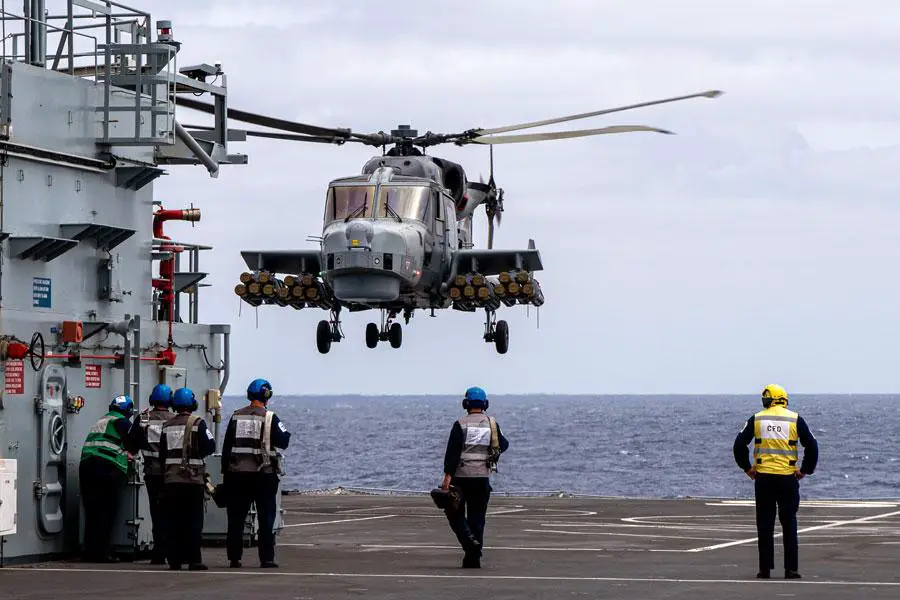Month-long trials in the Atlantic have paved the way for global operations using Royal Navy’s new ship-busting missiles. Martlet and Sea Venom – the Navy’s two new air-to-surface anti-ship missiles – have completed extensive tests in the hands of expert aviators and scientists and a Wildcat helicopter. The trials in the Atlantic and Mediterranean will help write the manual for using the weapon in various weather and sea conditions – allowing Fleet Air Arm aviators to take out small and large threats to the Fleet. Argus sailed more than 8,000 miles in the Atlantic, mostly between the Canary Islands and Cape Verde, and then into the Mediterranean, chasing different weather conditions. Around 30 people – aircrew, scientists, meteorologists, test pilots/engineers and technicians from across the Navy, MoD, science and industry – were involved in the trials, which saw the Wildcat from 815 Naval Air Squadron land and take off more than 900 times in different conditions/with different payloads by day and night.
Both missiles come under the banner of the Future Anti-Surface Guided Weapon:
Martlet, a light missile weighing just 13kg, intended for smaller/lightly-protected targets
Sea Venom, with ten times the punch of Martlet for larger, more heavily armoured warships.
Fitting either on special ‘weapon wings’ affects the way the helicopter handles, so to determine the boundaries for safe flying – known as Ship Helicopter Operating Limits – a specially-modified Wildcat, packed with sensors, joined aviation training ship RFA Argus for a month. A myriad conditions impact on the performance of a helicopter: wind speed, direction and air flow over the deck, humidity, temperature, the sea state, pitch and roll of the deck, as well as the weight and configuration of the aircraft itself.

Once analysed, the data will guide air/ground crew – from those straight out of training to the most experienced Fleet Air Arm aviators – in operating a Martlet/Sea Venom-armed Wildcat on frigates, destroyers, auxiliaries and Queen Elizabeth-class carriers. From initial results, the team say the trials exceeded expectations as the Wildcat clocked up 87 hours with weapons loads in seven different configurations, with the helicopter on occasions loaded up to more than six tonnes. Martlet was fired on deployment for the first time last autumn during HMS Queen Elizabeth’s mission to the Pacific. It’s intended to take out smaller threats to the Fleet – fast attack craft, motor boats, patrol boats with its 3kg explosive charge as Martlet smashes into its target at twice the speed of sound. Sea Venom is twice the size, has more than double the range and is fitted with a 30kg charge. Each Wildcat can carry up to four – or a combination of Sea Venom and Martlets.
Martlet is a lightweight air-to-surface, surface-to-air, and surface-to-surface missile developed by Thales Air Defence for the United Kingdom. Developed as the Lightweight Multirole Missile (LMM) to meet the UK’s “Future Air-to-Surface Guided Weapon (Light)” requirement, the Ministry of Defence (MOD) placed an initial order for 1,000 missiles with deliveries due to start in 2013. Sea Venom is an Anglo-French lightweight anti-ship missile developed by MBDA to equip the French Navy and the Royal Navy. The missile is known as Anti-Navire Léger (ANL) in France and Sea Venom (formerly “Future Anti-Surface Guided Weapon (Heavy)”) in the United Kingdom. While initial operating capability had been expected with the Royal Navy in 2022, Sea Venom missiles were reported deployed with Royal Navy Wildcat helicopters operating as part of the Royal Navy’s carrier strike group in 2021. Sea Venom is designed as a successor to the French Navy’s AS 15 TT and Royal Navy’s Sea Skua missiles.
















